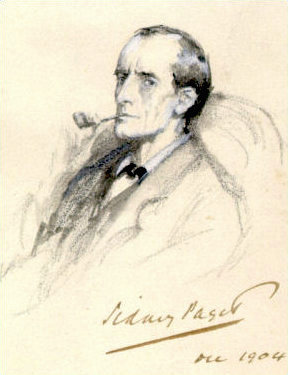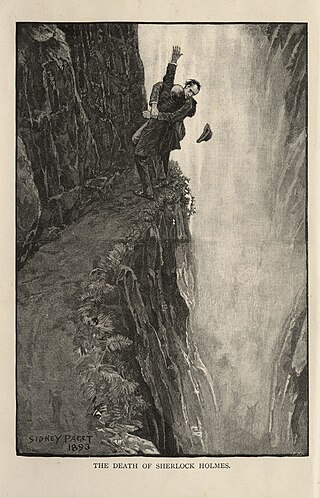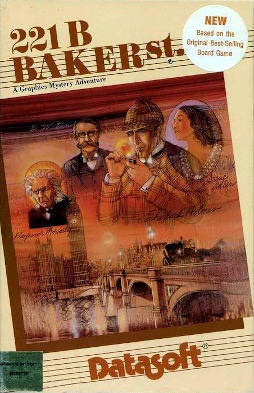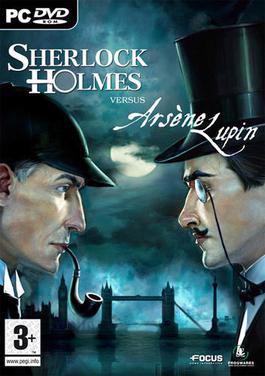Infocom was an American software company based in Cambridge, Massachusetts, that produced numerous works of interactive fiction. They also produced a business application, a relational database called Cornerstone.

Sherlock Holmes is a fictional detective created by British author Arthur Conan Doyle. Referring to himself as a "consulting detective" in the stories, Holmes is known for his proficiency with observation, deduction, forensic science and logical reasoning that borders on the fantastic, which he employs when investigating cases for a wide variety of clients, including Scotland Yard.

Mycroft Holmes is a fictional character appearing in stories written by Sir Arthur Conan Doyle from 1893 to 1908. The elder brother of detective Sherlock Holmes, he is a government official and a founding member of the Diogenes Club. Mycroft is described as having abilities of deduction and knowledge exceeding even those of his brother, though their practical use is limited by his dislike of fieldwork.

"The Final Problem" is a short story by Sir Arthur Conan Doyle featuring his detective character Sherlock Holmes. It was first published in The Strand Magazine in the United Kingdom, and McClure's in the United States, under the title "The Adventure of the Final Problem" in December 1893. It appears in book form as part of the collection The Memoirs of Sherlock Holmes.

The Lost Treasures of Infocom is a 1991 compilation of 20 previously-released interactive fiction games developed by Infocom. It was published by Activision for MS-DOS, Macintosh, Amiga, and Apple IIGS versions. It was later re-released on CD-ROM, and in 2012 on iOS.

Arthur: The Quest for Excalibur is an illustrated interactive fiction video game written by Bob Bates and published by Infocom in 1989. It was released for the Apple II, Amiga, Macintosh, and IBM PC compatibles. Atypically for an Infocom product, it shows illustrations of locations, characters and objects within the game. It is Infocom's thirty-fourth game and is the second of two Infocom games developed by Challenge using Infocom's development tools.

Colonel Sebastian Moran is a fictional character in the stories written by Arthur Conan Doyle. An enemy of Sherlock Holmes, he first appears in the 1903 short story "The Adventure of the Empty House". Holmes once described him as "the second most dangerous man in London", the most dangerous being Professor Moriarty, Moran's employer.

Without a Clue is a 1988 British comedy film directed by Thom Eberhardt and starring Michael Caine and Ben Kingsley. It is based on Sir Arthur Conan Doyle's characters from the Sherlock Holmes stories but, in this version, the roles are reversed: Dr. John Watson is the brilliant detective, while "Sherlock Holmes" is an actor hired to pose as the detective so that Watson can protect his reputation as a physician.

Robert Bates is an American computer game designer. One of the early designers of interactive fiction games, he was co-founder of Challenge, Inc., which created games in the 1980s for the pioneering company Infocom. After Infocom's dissolution in 1989, Bates co-founded Legend Entertainment to continue publishing games in the Infocom tradition, but with added graphics. Notable games that he has designed, written, or produced include Unreal II (2003), Spider-Man 3 (2007), and Eric the Unready (1993), listed as Adventure Game of the Year by Computer Gaming World magazine and also included on the 1996 list of "150 best games of all time". In 1998 he wrote the award-winning game Quandaries for the U.S. Department of Justice. He has twice been the chairperson of the International Game Developers Association, which honored him with a Lifetime Achievement Award in 2010. Bates has written extensively about game design and development in works such as the 2001 book Game Design: The Art and Business of Creating Games, which is commonly used as a game design textbook in college courses. From 2011–2014, Bates was Chief Creative Officer for External Studios at Zynga. He continues to work as an independent consultant with various publishers in the games industry.

Sherlock Holmes: Consulting Detective is a full-motion video game released in 1991. It is based on a tabletop game-gamebook hybrid of the same name first published in 1981, and features the fictional detective Sherlock Holmes, created by Arthur Conan Doyle.
The stories of Sherlock Holmes by Sir Arthur Conan Doyle have been very popular as adaptations for the stage, and later film, and still later television. The four volumes of the Universal Sherlock Holmes (1995) compiled by Ronald B. De Waal lists over 25,000 Holmes-related productions and products. They include the original writings, "together with the translations of these tales into sixty-three languages, plus Braille and shorthand, the writings about the Writings or higher criticism, writings about Sherlockians and their societies, memorials and memorabilia, games, puzzles and quizzes, phonograph records, audio and video tapes, compact discs, laser discs, ballets, films, musicals, operettas, oratorios, plays, radio and television programs, parodies and pastiches, children's books, cartoons, comics, and a multitude of other items — from advertisements to wine — that have accumulated throughout the world on the two most famous characters in literature."
Sherlock Holmes has long been a popular character for pastiche, Holmes-related work by authors and creators other than Arthur Conan Doyle. Their works can be grouped into four broad categories:

221B Baker Street is a 1986 video game published by Datasoft, based on an earlier board game of the same name. The game was inspired by the exploits of Arthur Conan Doyle's fictional detective Sherlock Holmes and derives its title from the detective's residence at 221B Baker Street in London.
Classic Text Adventure Masterpieces of Infocom is a collection of 33 computer games from interactive fiction pioneer Infocom, and the top 6 winners of the 1995 Interactive Fiction Competition, released in 1996. All 39 games are combined on a single cross-platform CD-ROM, which also includes PDFs of all the Infocom games' instructions, maps, and hint booklets.
Many writers make references to Sir Arthur Conan Doyle's famous literary creation, the detective Sherlock Holmes, and these often become embedded within popular culture. While Holmes exists predominantly in the context of Victorian-era London, he has been mentioned in such outre contexts as the 22nd century or hunting aliens or supernatural enemies. These references are in addition to the innumerable passing references to Sherlock Holmes made in many literary and cinematic works, such as the labeling of a person as a "Sherlock", whether in reference to their intelligence.

The Adventures of Sherlock Holmes is a 1939 American mystery adventure film based on Sir Arthur Conan Doyle's Sherlock Holmes detective stories. Although claiming to be an adaptation of the 1899 play Sherlock Holmes by William Gillette, the film bears little resemblance to the play.

Sherlock Holmes Versus Arsène Lupin is an adventure game developed by Frogwares. The fourth game in the Sherlock Holmes series, it was released in October 2007 and is distributed by Focus Home Interactive. It was preceded in 2002 by Sherlock Holmes: The Mystery of the Mummy, in 2004 by Sherlock Holmes: The Case of the Silver Earring and in 2007 by Sherlock Holmes: The Awakened.

Sherlock Holmes and the Secret Weapon (1942) is the fourth in the Basil Rathbone/Nigel Bruce series of 14 Sherlock Holmes films which updated the characters created by Sir Arthur Conan Doyle to the then present day. The film is credited as an adaptation of Conan Doyle's 1903 short story "The Adventure of the Dancing Men," though the only element from the source material is the dancing men code. Rather, it is a spy film taking place on the background of the then ongoing Second World War with an original premise. The film concerns the kidnapping of a Swiss scientist by their nemesis Professor Moriarty, to steal a new bomb sight and sell it to Nazi Germany. Sherlock Holmes and Dr. John Watson have to crack a secret code in order to save the country.
The Sherlockian game is the pastime of attempting to resolve anomalies and clarify implied details about Sherlock Holmes and Dr. Watson from the 56 short stories and four novels that make up the Sherlock Holmes canon by Arthur Conan Doyle. It treats Holmes and Watson as real people and uses aspects of the canonical stories combined with the history of the era of the tales' settings to construct fanciful biographies of the pair.

Meitantei Holmes: M-Kara no Chousenjou is a modern first-person adventure video game for the Family Computer that is based on the stories by Arthur Conan Doyle. It is the sequel to Sherlock Holmes: Hakushaku Reijō Yūkai Jiken and Meitantei Holmes: Kiri no London Satsujin Jiken, the latter having been released on May 13, 1988. In Kiri no London Satsujin Jiken, the player takes control of Holmes and Watson in the streets of London. The player can collect clues and also shillings in order to pay for things such as a coach fare, which allows them to travel London faster. All of these video games were released exclusively in Japan.














